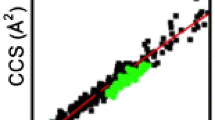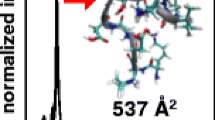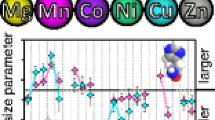Abstract
The first systematic and comprehensive study of the charging behaviour and effect of charge on the conformation of specifically constructed arginine-rich peptides and its significance to the N- and C-terminal basic tail regions of histone proteins was conducted using ion mobility mass spectrometry (IM-MS). Among the basic amino acids, arginine has the greatest impact on the charging behaviour and structures of gas phase ions by virtue of its high proton affinity. A close linear correlation was found between either the maximum charge, or most abundant charge state, that the peptides support and their average collision cross section (CCS) values measured by ion mobility mass spectrometry. The calculated collision cross sections for the lowest energy solution state models predicted by the PEP-FOLD algorithm using a modified MOBCAL trajectory method were found to best correlate with the values measured by IM-MS. In the case of the histone peptides, more compact folded structures, supporting less than the maximum number of charges, were observed. These results are consistent with those previously reported for histone dimers where neutralization of the charge at the basic residues of the tail regions did not affect their CCS values.







Similar content being viewed by others
References
Dyson HJ, Wright PE. Defining solution conformations of small linear peptides. Ann Rev Biophys Biophys Chem. 1991;20:519–38.
Baldwin RL, Rose GD. Is protein folding hierarchic? I. Local structure and peptide folding. Trends Biochem Sci. 1999;24:26–33.
Mayo KH, Fields GB. Peptides as models for understanding protein folding. Adv Mol Cell Biol. 1997;22:567–612.
Becker OM, Levy Y, Ravitz O. Flexibility, conformation spaces, and bioactivity. J Phys Chem B. 2000;104:2123–35.
Moore G. Designing peptide mimetics. Trends Pharmacol Sci. 1994;15:124–9.
Blundell T, Wood S. The conformation, flexibility, and dynamics of polypeptide hormones. Annu Rev Biochem. 1982;51:123–54.
Hruby VJ. Designing molecules: specific peptides for specific receptors. Epilepsia. 1989;30:S42–50.
Dyson HJ, Wright PE. Antigenic peptides. FASEB J. 1995;9:37–42.
Bowie JH, Separovic F, Tyler MJ. Host-defense peptides of Australian anurans. Part 2. Structure, activity, mechanism of action, and evolutionary significance. Peptides. 2012;37:174–88.
Serpell LC. Alzheimer’s amyloid fibrils: structure and assembly. Biochimica et Biophysica Acta (BBA) - Molecul Basis Dis. 2000;1502:16–30.
Zhou P, Huang J, editors. Computational peptidology, methods in molecular biology. New York: Springer; 2015.
Craig LC, Cowburn D, Bleich H. Methods for the study of the conformation of small peptide hormones and antibiotics in solution. Annu Rev Biochem. 1975;44:477–90.
Akashi S. Investigation of molecular interaction within biological macromolecular complexes by mass spectrometry. Med Res Rev. 2006;26:339–68.
Downard KM. Mass spectrometry of protein interactions. New York: John Wiley and Sons; 2007.
Grandori R. Origin of the conformation dependence of protein charge-state distributions in electrospray ionization mass spectrometry. J Mass Spectrom. 2003;38:11–5.
Konijnenberga A, Butterera A, Sobott F. Native ion mobility-mass spectrometry and related methods in structural biology. Biochimica et Biophysica Acta Protein Proteom. 1834;2013:1239–56.
Lanucara F, Holman SW, Gray CJ, Eyers CE. The power of ion mobility-mass spectrometry for structural characterization and the study of conformational dynamics. Nat Chem. 2014;6:281–94.
Downard KM, Maleknia SD, Akashi S. Impact of limited oxidation on protein ion mobility and structure of importance to footprinting by radical probe mass spectrometry. Rapid Commun Mass Spectrom. 2012;26:226–30.
Akashi S, Maleknia SD, Saikusa K, Downard KM. Stability of the βB2B3 crystallin heterodimer to increased oxidation by radical probe and ion mobility mass spectrometry. J Struct Biol. 2015;189:20–7.
Maleknia SD, Downard KM. Advances in radical probe mass spectrometry for protein footprinting in chemical biology applications. Chem Soc Rev. 2014;43:3244–58.
Jarrold MF. Peptides and proteins in the vapor phase. Annu Rev Phys Chem. 2000;52:179–207.
Hilderbrand AE, Clemmer DE. Determination of sequence-specific intrinsic size parameters from cross sections for 162 tripeptides. J Phys Chem B. 2005;109:11802–9.
Valentine SJ, Ewing M, Dilger JM, Glover M, Geromanos S, Hughes C, et al. Using ion mobility data to improve peptide identification: cross section databases and intrinsic amino acid size parameters. J Proteome Res. 2011;10:2318–29.
Harvey SR, Macphee CE, Barran PE. Ion mobility mass spectrometry for peptide analysis. Methods. 2011;54:454–61.
Baldauf C, Rossi M. Going clean: structure and dynamics of peptides in the gas phase and paths to solvation. J. Phys Condens Matter. 2015;27:493002.
Bleiholder C, Dupuis NF, Wyttenbach T, Bowers MT. Ion mobility-mass spectrometry reveals a conformational conversion from random assembly to β-sheet in amyloid fibril formation. Nat Chem. 2011;3:172–7.
Silveira JA, Fort KL, Pierson NA, Clemmer DE, Russell DH. From solution to the gas phase: stepwise dehydration and kinetic trapping of substance P reveals the origin of peptide conformations. J Am Chem Soc. 2013;135:19147–53.
Wyttenbach T, Pierson NA, Clemmer DE, Russell DH. Ion mobility analysis of molecular dynamics. Annu Rev Phys Chem. 2014;65:175–96.
Downard KM, Biemann K. Charging behavior of highly basic peptides during electrospray ionization. A predilection for protons. Int J Mass Spectrom Ion Proc. 1995;148:191–202.
Downard KM, Biemann K. The effect of charge state and the localization of charge on the collision-induced dissociation of peptide ions. J Am Soc Mass Spectrom. 1993;5:966–75.
Shimoyama S, Nagadoi A, Tachiwana H, Yamada M, Sato M, Kurumizaka H, et al. Deimination stabilizes histone H2A/H2B dimers as revealed by electrospray ionization mass spectrometry. J Mass Spectrom. 2010;45:900–8.
Saikusa K, Fuchigami S, Takahashi K, Asano Y, Nagadoi A, Tachiwana H, et al. Gas phase structure of the histone multimers characterized by ion mobility mass spectrometry and molecular dynamics simulation. Anal Chem. 2013;85:4165–71.
Biswas M, Voltz K, Smith JC, Langowski L. Role of histone tails in structural stability of the nucleosome. PLoS Comput Biol. 2011;7:e1002279.
Saikusa K, Nagadoi A, Hara K, Fuchigami S, Kurumizaka H, Nishimura Y, et al. Mass spectrometric approach for characterizing the disordered tail regions of the histone H2A/H2B dimer. Anal Chem. 2015;87:2220–7.
Saikusa K, Shimoyama S, Asano Y, Nagadoi A, Sato M, Kurumizaka H, et al. Charge neutralization effect of the tail regions on the histone H2A/H2B dimer structure. Protein Sci. 2015;24:1224–31.
Pringle SD, Giles K, Wildgoose JL, Williams JP, Slade SE, Thalassinos K, et al. An investigation of the mobility separation of some peptide and protein ions using a new hybrid quadrupole/travelling wave IMS/oa-ToF instrument. Int J Mass Spectrom. 2007;261:1–12.
Giles K, Williams JP, Campuzano I. Enhancements in travelling wave ion mobility resolution. Rapid Commun Mass Spectrom. 2011;25:1559–66.
Bush MF, Campuzano I, Robinson CV. Ion mobility mass spectrometry of peptide ions: effects of drift gas and calibration strategies. Anal Chem. 2012;84:7124–30.
Shen Y, Maupetit J, Derreumaux P, Tufféry P. Improved PEP-FOLD approach for peptide and miniprotein structure prediction. J Chem Theor Comp. 2014;10:4745–58.
DeLano WL. The PyMOL molecular graphics system. (2002);http://www.pymol.org.
Mesleh MF, Hunter JM, Shvartsburg AA, Schatz GC, Jarrold MF. Structural information from ion mobility measurements: effects of the long range potential. J Phys Chem. 1996;100:16082–6.
Shvartsburg AA, Jarrold MF. An exact hard spheres scattering model for the mobilities of polyatomic ions. Chem Phys Lett. 1996;261:86–91.
Gronert S, Simpson DC, Conner KM. A reevaluation of computed proton affinities for the common α-amino acids. J Am Soc Mass Spectrom. 2009;20:2116–23.
Sudha R, Jarrold MF. Left-handed and ambidextrous helices in the gas phase. J Phys Chem B. 2005;109:11777–80.
Xiao C, Pérez LM, Russell DH. Effects of charge states, charge sites and side chain interactions on conformational preferences of a series of model peptide ions. Analyst. 2015;140:6933–44.
Marqusee S, Robbins VH, Baldwin RL. Unusually stable helix formation in short alanine-based peptides. Proc Natl Acad Sci U S A. 1989;86:5286–90.
Shvartsburg AA, Jarrold MF. MobCal. http://www.indiana.edu/~nano/software/.
Acknowledgments
The Waters Synapt G2 ion mobility mass spectrometer used in these investigations was purchased with funds provided by a Grant-in-Aid for Scientific Research in Innovative Areas (21113003) (to S. Akashi) from the Ministry of Education, Culture, Sports, Science and Technology, Japan. The authors are grateful to Prof. Hajime Tanuma (Tokyo Metropolitan University) who provided an algorithm that allowed for the calculation of peptide theoretical collision cross sections (CCS) in nitrogen gas. The authors thank Asst. Prof. Kazumi Saikusa (Hiroshima University) who implemented the algorithm and helped with their calculation.
Author information
Authors and Affiliations
Corresponding author
Ethics declarations
Conflict of interest
The authors declare that they have no conflict of interest.
Rights and permissions
About this article
Cite this article
Akashi, S., Downard, K.M. Effect of charge on the conformation of highly basic peptides including the tail regions of histone proteins by ion mobility mass spectrometry. Anal Bioanal Chem 408, 6637–6648 (2016). https://doi.org/10.1007/s00216-016-9777-4
Received:
Revised:
Accepted:
Published:
Issue Date:
DOI: https://doi.org/10.1007/s00216-016-9777-4




